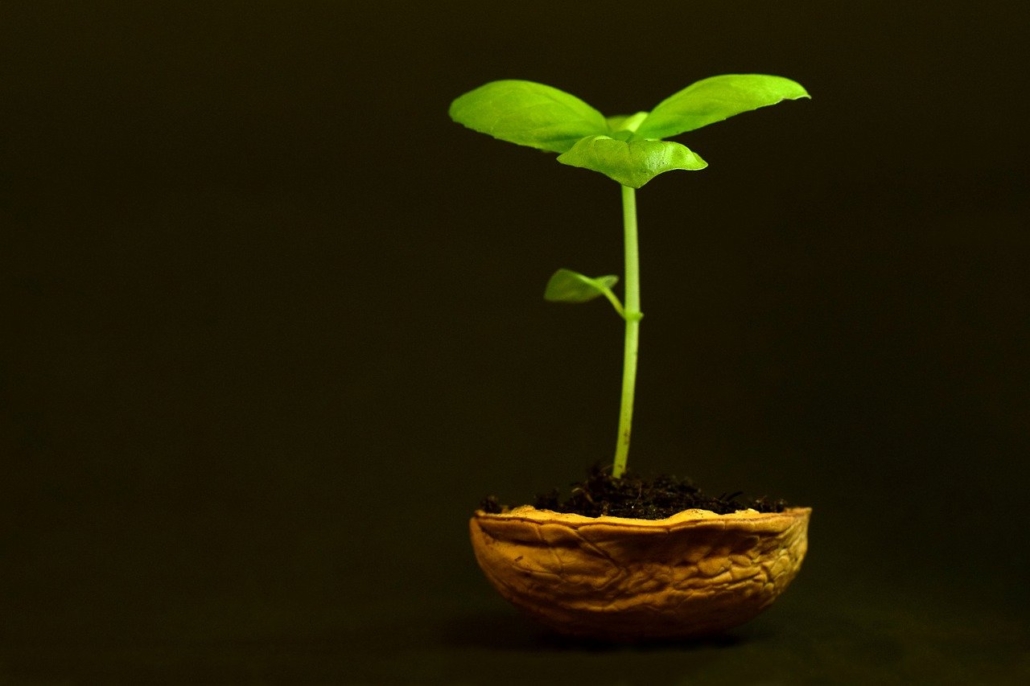GARDEN WORKS: Nine tips for starting seedlings successfully indoors
 Anyone can do this!
Anyone can do this!
Reprint from February 2015
 by Emily Cates
by Emily Cates
Really? Now? YES! I’ll admit it’s hard to imagine a lush, productive garden when we’re up to our eyeballs in snow. But if we put our green thumbs to work, it just might be what we need to get us through.
Are you wondering which methods and materials you should use? Well, it really depends on the imagination and creativity of the individual. Systems can be as unique and diverse as time, space, and expense allow- even involving minimum inputs made from salvaged or recycled materials. With just a few things in mind, starting seeds is easy and practically anyone can do it. Why not give it a try? Here’s how:
The first important component to a successful operation, whether large or small, is a clean, well-drained container that holds the substrate. Possible candidates could include free and abundant used yogurt cups from home or the recycling center. Wash them well and poke holes in the bottoms, label them, fill with planting medium, and they’re good to go! Plastic or cardboard milk cartons with the tops cut off are another possibility. Also, there is this handy dandy little tool called the “pot maker” which you can use to make pots out of plain newsprint. If expense is not an issue and the desire is aesthetic, go for the plastic flats and 6-packs and such found in seed catalogs and gardening centers. Seeds can be individually or collectively sown in smaller containers, but the resulting seedlings are easier to transplant if they are in flats or containers with a larger surface area.
The second ingredient to successful seedlings is the substrate. Always remember to use fresh, pest and disease-free planting medium, whether purchased or homemade. FEDCO and Johnny’s carry satisfactory seed starting mixes along with nifty items such as soil block makers, pots made from composted cow manure, and “seed discs” (for the horticulturally-challenged!).
The third part of the system that deserves consideration is light. This could be as simple as a sunny, south-facing windowsill, a shop light with full spectrum bulbs (found at Home Depot), or the luxury of a sun room or heated greenhouse. To prevent seedlings from becoming leggy once they’ve sprouted keep the containers as close to the lights as possible without burning the plants.
The fourth piece we want to scrutinize is an acceptable source of water. Watering with plain tap water is fine as long as it’s not chlorinated or from a softener system. Keep the seeds and seedlings moist, but not waterlogged. If necessary, additional draining holes in the container can be poked through or drilled.
The fifth factor of importance is the temperature. 80 degrees F and above are necessary for proper germination, so a heat mat or other source of warmth could be used in a cold room.
The sixth essential element is ensuring the seeds are viable. Using seeds that are fresh and stored in a cool, dry area will have a higher germination rate. If in doubt, pack a few into a damp paper towel, place into a zip lock bag, and store for several days in a warm place. Check daily for sprouts, keep moist, and observe. Sometimes it might be necessary to wait a week or two more, but after that I’d give up and buy new seed for sure.
The seventh module we’ll look at is what to plant. Long-season seedlings that seem to take forever and ever to get to a plant-able size from seed may be happiest and most productive when started early. The cast of characters starring in your grow system could include leeks, onions, peppers, tomatoes, eggplant, long-season herbs, and perennial flowers.
The eighth constituent is when to plant. This involves finding out the recommended planting time frame. Check a seed packet or gardening book for planting instructions and you might find that the time to start the seeds for your favorite plant is now! (But not too early, unless you plan on transplanting into bigger and bigger pots later on as they grow- and using up more and more planting medium!) Personally, I prefer to start smaller, later-planted seedlings and let them catch up, as opposed to jumping the gun and ending up with oversized, pot-bound, sulking plants. I’ve even waited until a few weeks or so after the recommended planting time-frames and observed that the later plantings will oftentimes catch up with the earlier ones. I’ve noticed this to be especially so as the moon is increasing (when I try to start seeds), since it appears that a full moon has an affinity towards fertility and growth. The point? Starting seeds is a flexible endeavor and will accommodate a variety of schedules.
The ninth and final feature of a successful grow system involves nutrition. My favorite is fish-seaweed formulas, used as directed. Don’t worry about it until the first set of true leaves has formed and weekly thereafter.
Here’s hoping your seedlings are happy and healthy when the above needs are considered. Enjoy gardening now in the comfort and convenience of a warm room while the cold winter wind is whipping outside!
Responsible journalism is hard work!
It is also expensive!
If you enjoy reading The Town Line and the good news we bring you each week, would you consider a donation to help us continue the work we’re doing?
The Town Line is a 501(c)(3) nonprofit private foundation, and all donations are tax deductible under the Internal Revenue Service code.
To help, please visit our online donation page or mail a check payable to The Town Line, PO Box 89, South China, ME 04358. Your contribution is appreciated!


Leave a Reply
Want to join the discussion?Feel free to contribute!